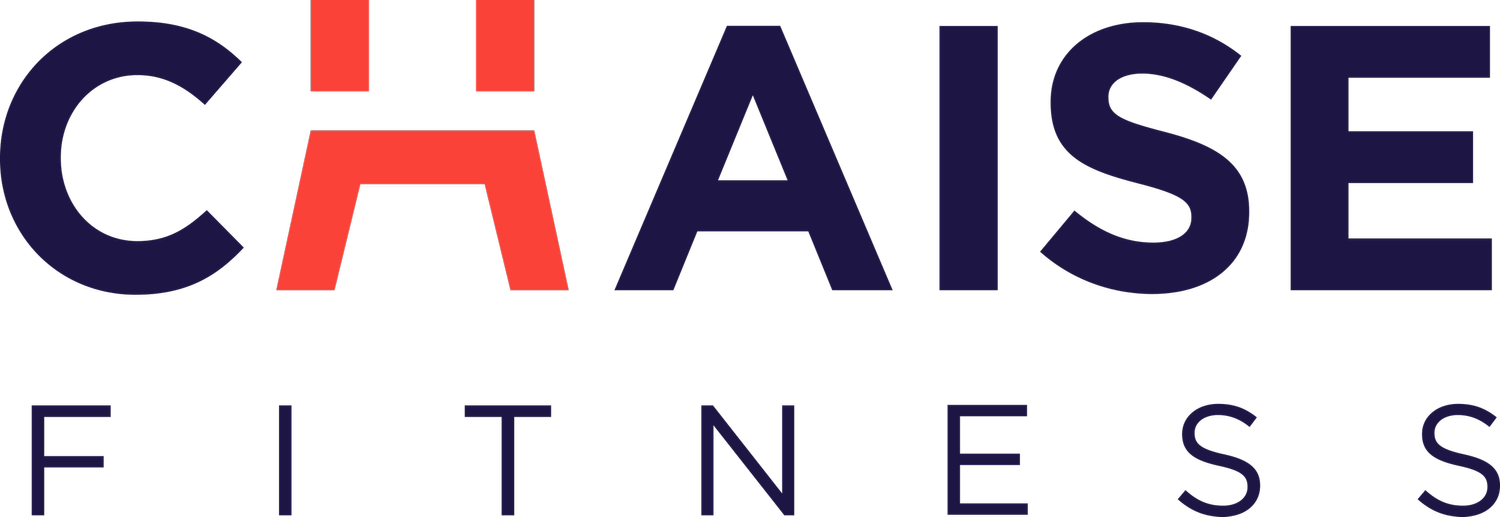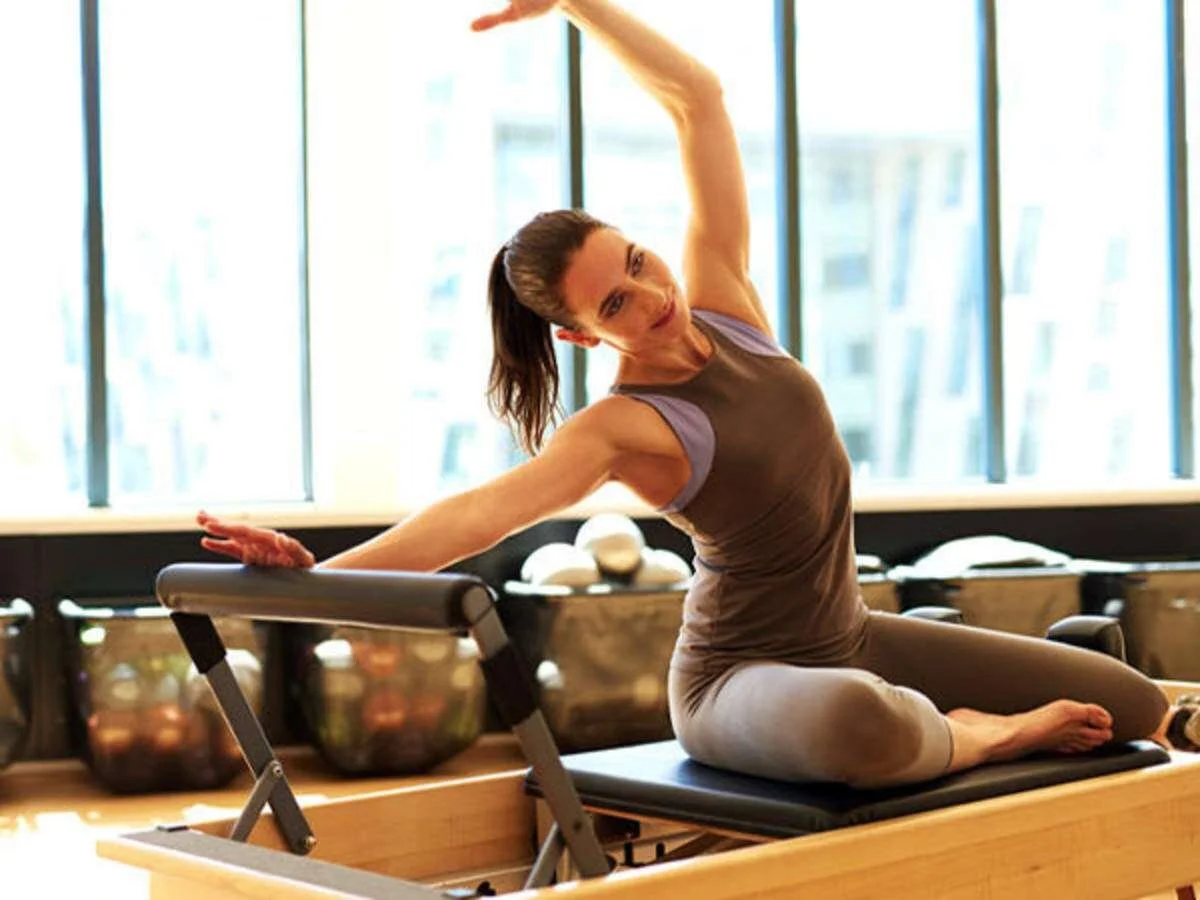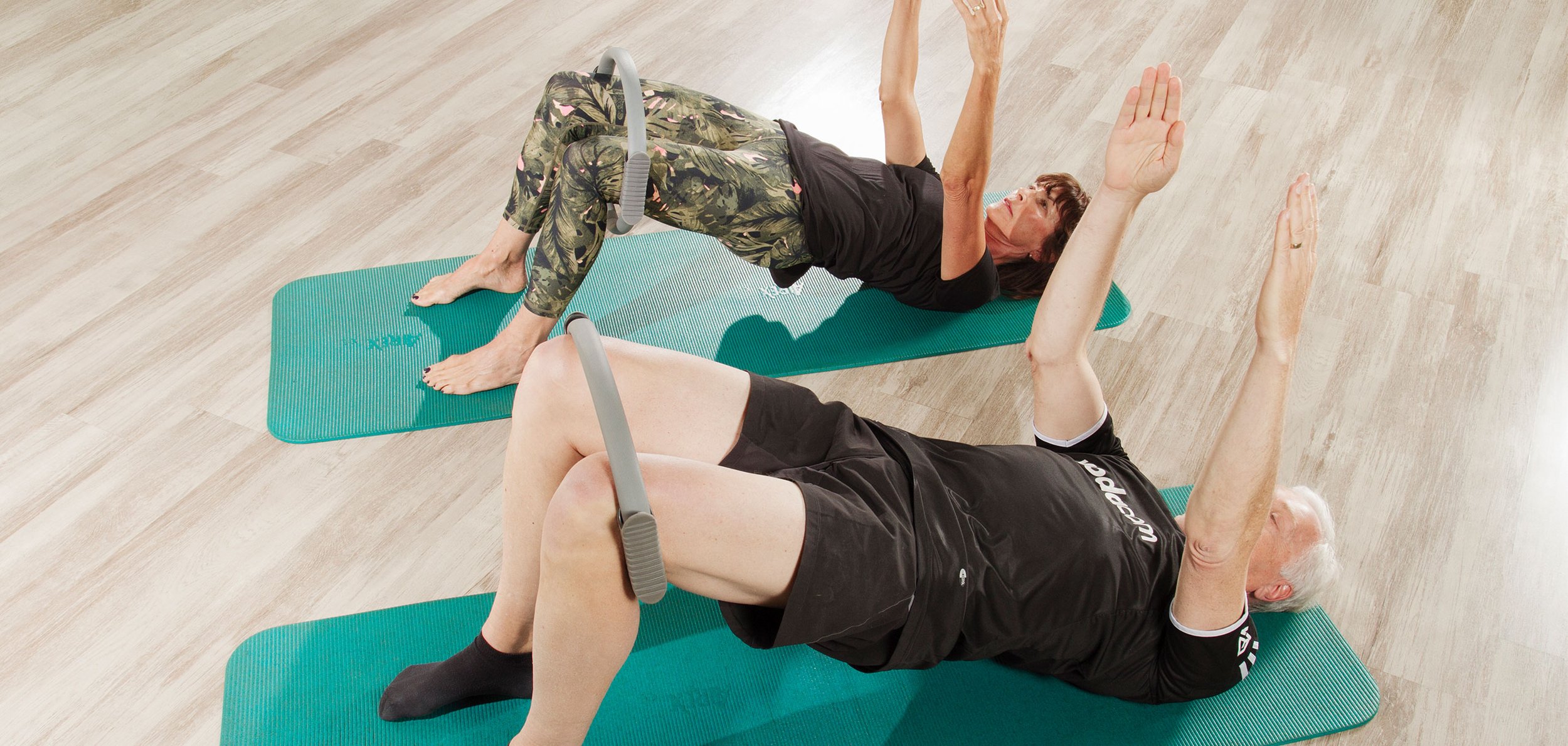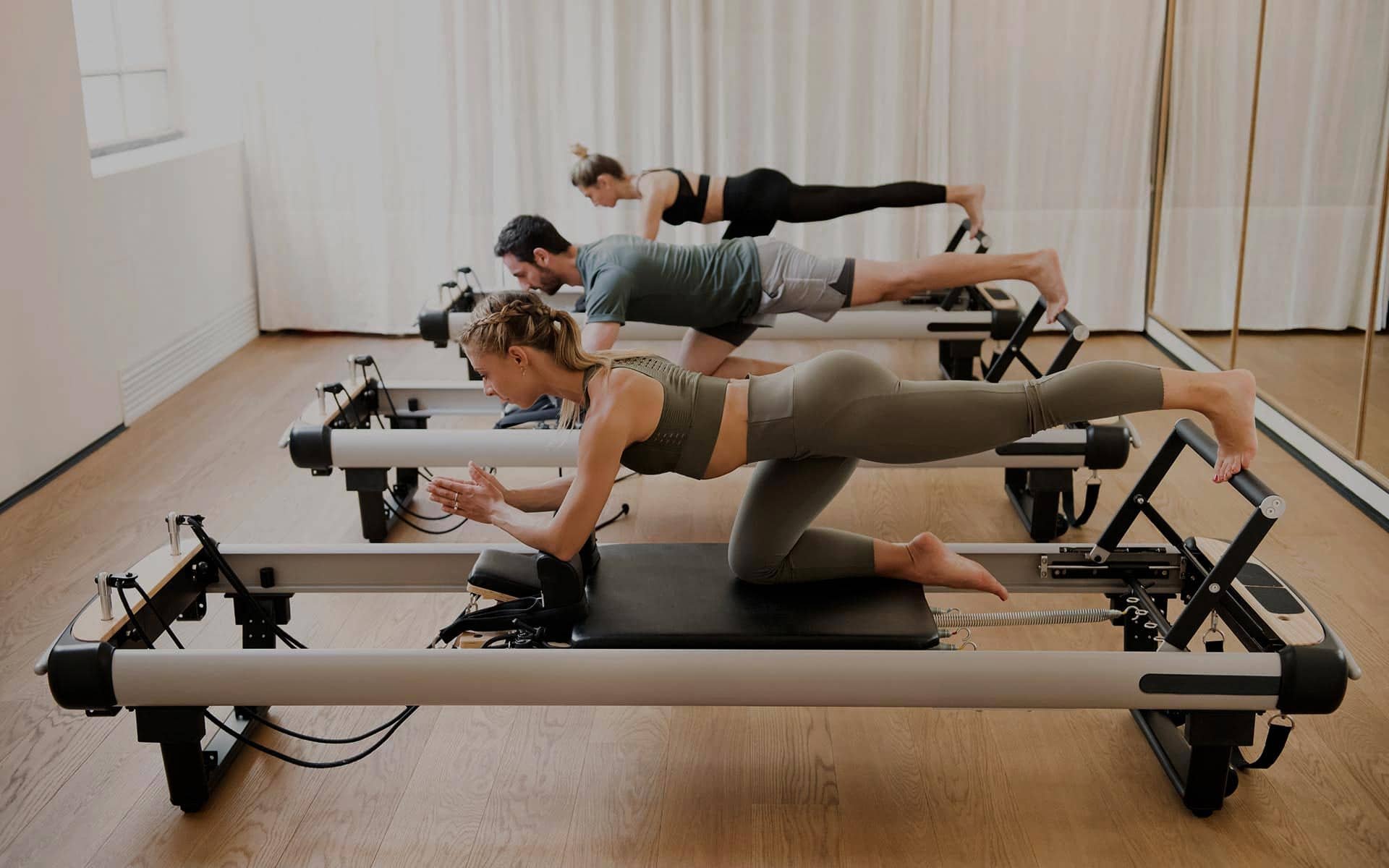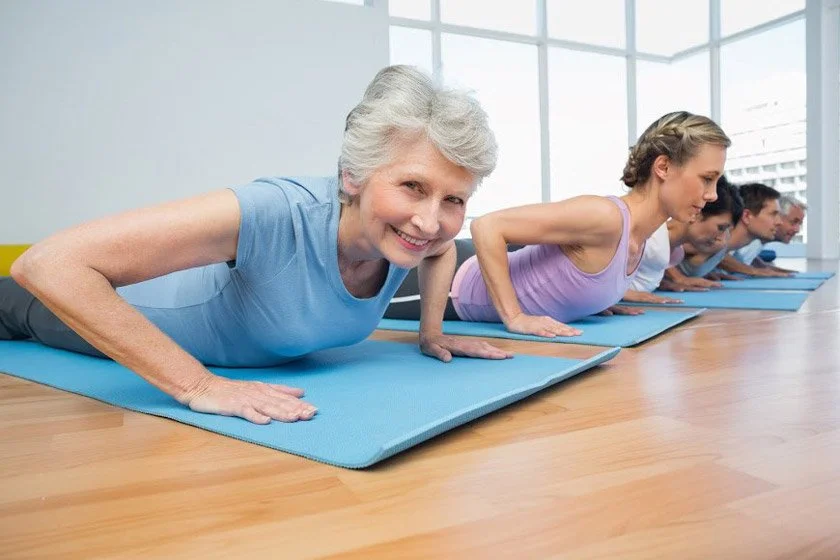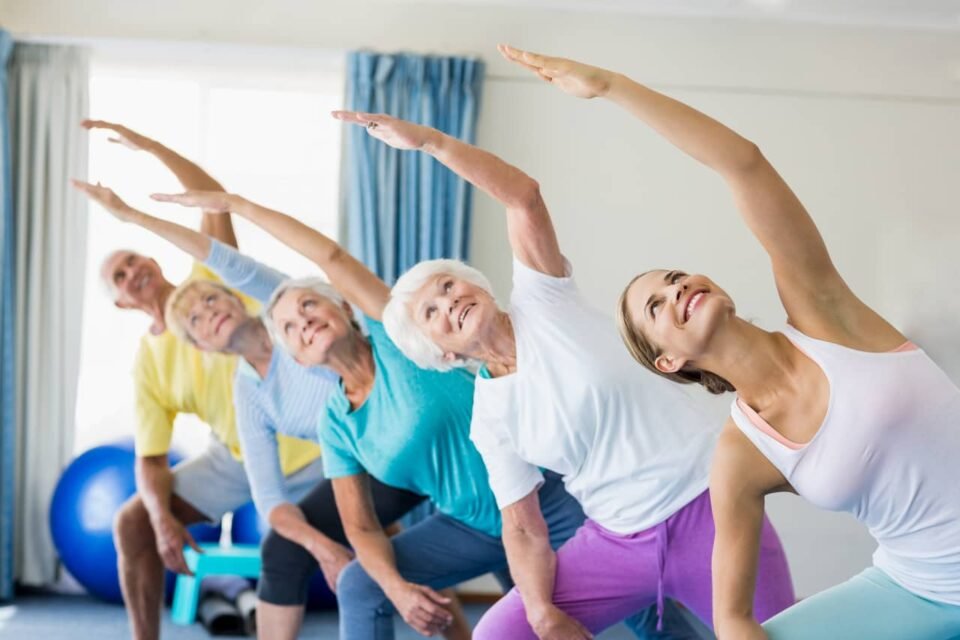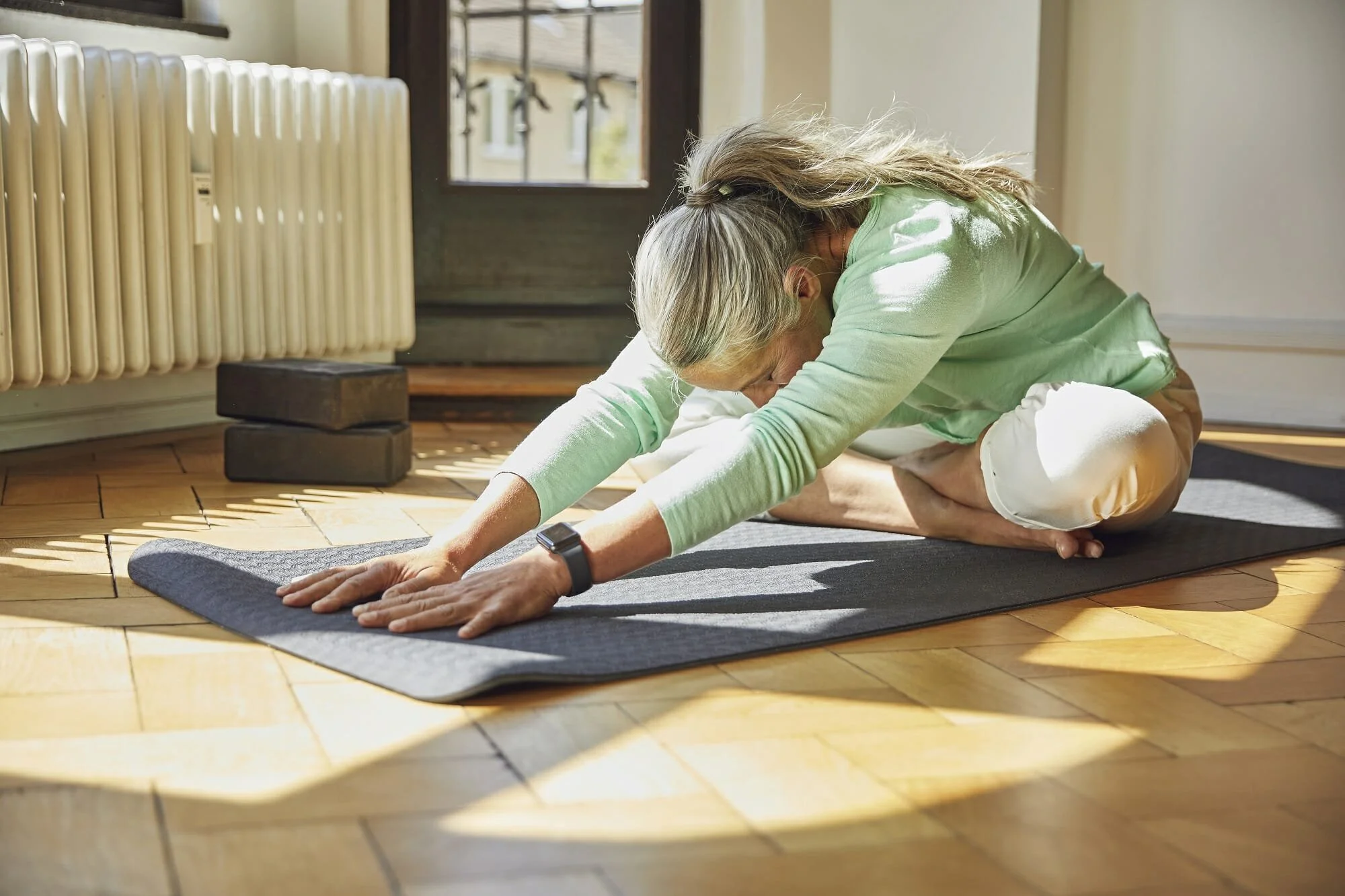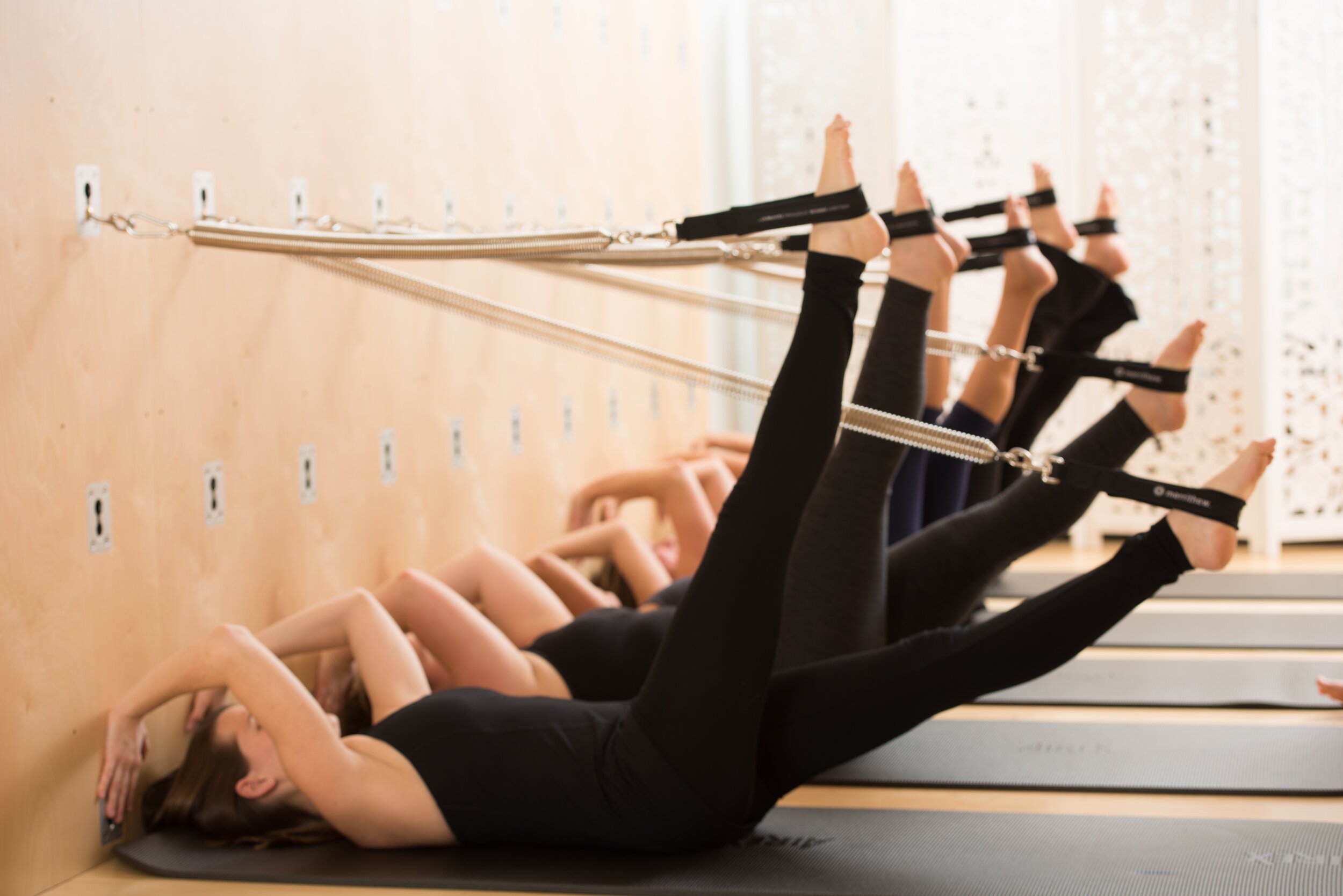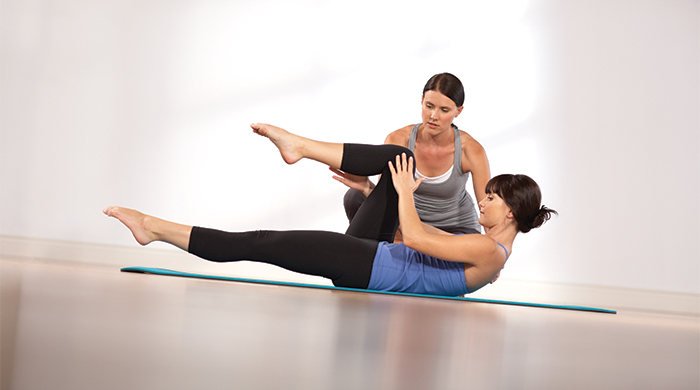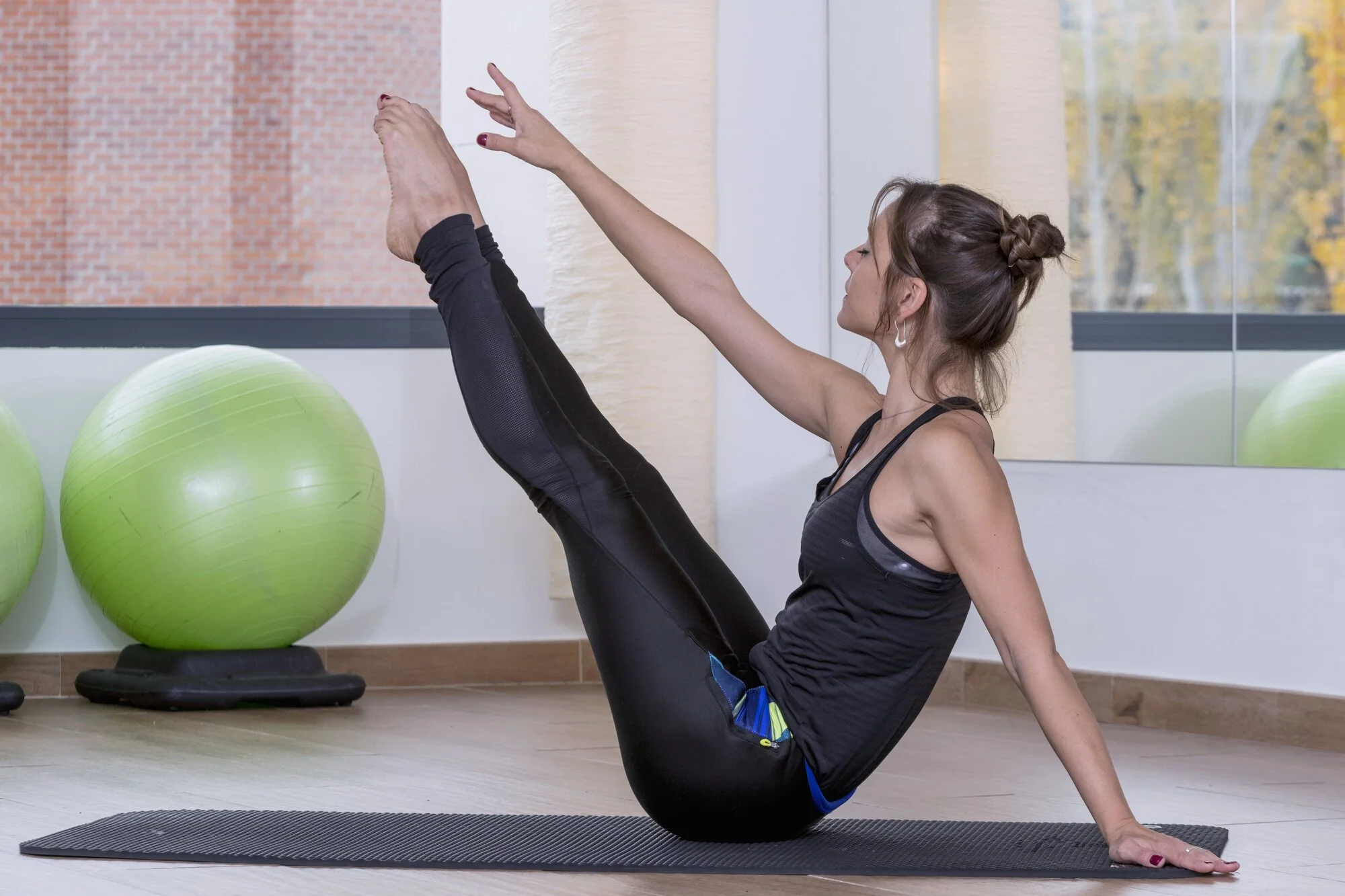Tips for People New to Pilates Class
Are you new to Pilates or thinking about starting up a NYC Pilates class? Pilates can be an awesome workout for anyone looking to improve their physical fitness. Pilates is an excellent way to lose weight if you are looking to tone your body and not bulk up. In only eight weeks, researchers found that Pilates classes help reduce body fat, lower BMI, and shrink the circumference of the abdomen and hips. However, it is better suited for those looking to tone their muscles, rather than grow them. The motions done in Pilates won't cause your lean body mass to rise to the same extent as lifting weights do.
What to expect for your first NYC Pilates class & tips for how to prepare
1. Dress properly
When going to your first Pilates class, you should dress the part. Wear form-fitting clothes, especially if it’s a virtual class. Qualified Upper East Side Pilates instructors are trained to see the smallest misalignment in your body. Use that to your advantage by making sure they can see you clearly.
You should wear clothing that is comfortable and does not restrict your body's movements, much as you would when exercising in yoga or indoor cycling class. Wearing correctly-sized clothes will not only make you feel more at ease but will also assist the instructor in seeing any mistakes you are making. This may help you reach your goals faster and prevent any injuries. Keep some grippy socks handy since Pilates exercises are done without shoes. Slipping on your Pilates mat is not only frustrating but dangerous. To reduce the risk of slipping, purchase socks that have grips on the bottom--many sporting goods stores sell these types of socks.
2. Have the right mindset
Pilates requires practice. Learning is a continuous journey that you will be on forever, both in how to use your mind and body. When it comes to exercises or cues given by your instructor, try not to overthink them too much. Instead, focus on using your Pilates practice as a way of growing and improving yourself personally. Chances are, movements that were difficult for you at first will suddenly become easier with time and practice.
3. Remember the 6 principles
The six core principles have always guided the practice since Joseph Pilates created it. When performing each action, your instructor will most likely refer to these principles throughout the class.
The six principles of Pilates are:
Concentration
Control
Center
Flow
Precision
Breathing
With this in mind, you should execute each Pilates exercise with care and precision. Joseph Pilates emphasized the need of maintaining control of your breathing throughout the exercises. If you catch yourself taking rapid and shallow breaths, slow things down and breathe fully into your diaphragm. While you may not be able to breathe like this for difficult portions of the class, it should always be something you aim to come back to.
4. Get ready to be sore all over
If you've never taken a Pilates lesson, your body could be in for a surprise. Expect muscular discomfort if you haven't done Pilates before. The straightforward response is that Pilates works all of your muscles. When most people hear ‘Pilates’, they think ‘core’. But your core is much more than your six-pack – it’s every muscle that contributes to stabilizing the spine and pelvis. This includes your back, glutes, inner and outer thighs, and all four sets of abdominals.
The class will focus on building your core muscles, but you'll also get a full-body workout. To prevent soreness afterward, stretch and stay hydrated. And don't forget: feeling pain after the fact is normal and actually means your body is changing for the better--if you keep going to class regularly, that is!
5. Prepare to hear new terms in class
Since Pilates is a group class, expect to hear some new terms that you've never heard before. These terms will be unique to each studio and gym, so you won't fully know the language until after your first class. That said, there are a few universal terms that you will hear in each Pilates class, no matter the Pilates instructor.
Some terms to remember are:
Neutral Spine: When a Pilates instructor tells you to keep a neutral spine, this means that you should keep a natural posture without any excess bending or leaning of your body. You should not be actively pushing your back to the floor or extending the spine’s natural curvature.
Dorsiflexion: This term describes the movement of your feet. When instructed to dorsiflex your feet, you should be pulling your toes backward towards your shins.
Powerhouse: Originally named by Joseph Pilates, the powerhouse refers to the center muscles of your body. Muscles like the abdominals, pelvic floor, hip muscles, and back extensors.
Any good Pilates instructor in Manhattan will clue you in and make sure beginners are following along, but you’ll get a leg up if you study some of these terms ahead of time.
Whether you're just starting your fitness journey or are looking for a new workout to add to your routine, Pilates is a great option with an interesting history. Manhattan Pilates classes focus on personal development, so come to your first class ready to learn the various movements. You may feel unsure of your talents at first, but you'll gradually improve as time goes on!
Looking for the Best Pilates Studio in the Upper East Side Area?
At ChaiseFitness, we believe that anyone can be fit—no matter what skill level or body type. This belief inspired the creation of our patented Reinvention Method, which is for everyone—the athlete, the dancer, the beginner, the advanced, the rebuilder. We blend Pilates, ballet, and strength training and equip you with a chair and overhead bungees so that you work out all your muscles every time. We are located in the Upper East Side in Manhattan. For more information, you can contact us at (973)996-2063, or visit our website.
Why Everyone Should Give Pilates a Try
Although Pilates is often mistaken for a somewhat less rigorous form of exercise, this is not the case. You will feel the benefits immediately following a Pilates session since it focuses on muscle strengthening and toning. So what exactly are the benefits of pilates and why should you consider checking out a NYC Pilates studio? Below are some of the top reasons why everyone should give pilates a try.
Pilates in NYC | Why Pilates is Great for Everyone
Pilates is Great for the Core:
Pilates is excellent for working your core! Do a few pilates sessions, and you'll notice a significant improvement in the strength of your core muscles! Pilates is an excellent way to tone your abs because the majority of the routines rely on balance, bodyweight, and core muscle strength.
Potentially Reduce Lower Pack Pain:
Pilates can help to reduce lower back pain. Have you ever had back or spine discomfort? The flow of benefits may include a reduction in lower back discomfort as a result of core strengthening through your pilates exercises. Strengthening the core muscles stabilizes the lumbar-pelvic (lower-back) region, reducing tension in the area.
Great for All Ages:
Pilates is suitable for people of all ages. This is due to the fact that each exercise focuses on muscle toning and strengthening with minimal stress on the joints. Because pilates improves your flexibility, it may aid in the rehabilitation of stiff joints by stimulating synovial fluid production. This has been found to enhance joint lubrication.
Good for Mental Well-Being:
Pilates is a great method for improving your physical and mental health but is especially beneficial to one's mental well-being. The calm atmosphere of a pilates class allows for a lot of attention and concentration as each exercise demands fluid breathing.
Pilates Will Improve Overall Flexibility:
Finally, Pilates actively enhances your overall flexibility. Many individuals exercise, but few pay attention to the importance of a good post-workout stretch. When you work out, your muscles tense and shorten. You're frequently restricted in motion when your muscles are tight because this limits your range of motion and can cause injury during your next workout. Pilates exercises provide a comprehensive mix of motions that aims to increase flexibility.
While Pilates is an excellent way to strengthen, tone, and stretch your body, it’s important to note that it isn’t, however, a high-intensity cardio session.
Are You Looking for a Great Pilates Studio in the Upper East Side Area in Manhattan?
At ChaiseFitness, we believe that anyone can be fit—no matter what skill level or body type. This belief inspired the creation of our patented Reinvention Method, which is for everyone—the athlete, the dancer, the beginner, the advanced, the rebuilder. We blend Pilates, ballet, and strength training and equip you with a chair and overhead bungees so that you work out all your muscles every time. We are located in the Upper East Side in Manhattan. For more information, you can contact us at (973)996-2063, or visit our website.
Why Taking a Pilates Class is Great for Injury Rehabilitation
Are you thinking about taking up a Pilates class as a means of injury rehabilitation? People have been enjoying the fitness regimen and reaping the numerous benefits of Pilates since it was first created in the early 20th century. It was originally developed as a substitute for injured dancers, but it has blossomed into a widespread fad with over 12 million practitioners worldwide today.
Pilates is a low-impact exercise, so your joints will not be put under strain as you exercise. This is an excellent alternative for millions of people who are unable to perform higher-impact exercises due to injury or other factors. When performed properly and frequently enough, pilates can create muscular strengthening effects. If you're big into Pilates or are just thinking about trying an Upper East Side Pilates class someday, below we will talk more about the rehabilitative benefits it offers!
Upper East Side Pilates | Benefits of Pilates for Injury Rehabilitation
1. Pilates Can Help People With Spinal Curvatures & Diseases:
In some cases, poor posture can lead to significant bodily damage, especially when the muscular strain is neglected for a long time. Ligaments, tendons, and muscles in your back and shoulders can be damaged by bad posture. This might induce discomfort as a result of compensatory and incorrect movement patterns, and eventually injury in some people.
Pilates can help fix this problem, which is frequently seen in individuals who work long hours sitting at a computer or those who have had scoliosis or spinal degenerative disease for many years. Pilates enables you to correctly position your spine and shoulders while strengthening your core and back muscles, allowing you to attain ideal posture and relieve some of the strain put on your spine. A Manhattan pilates session will also help you learn how to identify when your spine is not straight, allowing you to correct any problems. People who have scoliosis or a spinal problem may benefit greatly from this type of cognitive awareness.
2. Pilates Strengthens the Core, Helping With Muscular Symmetry & Spinal Health:
Pilates increases your core strength. The muscles of the core assist with a variety of activities, from walking to standing to running. They help you maintain your balance and posture, allowing you to function effectively and reducing the chance of injury.
Many people try Pilates for the first time after experiencing lower-back pain, which is caused by poor posture. The core muscles are strengthened so that your body does not have to overcompensate for inefficient movements, resulting in stiffness and tiredness. It allows muscles to operate freely while still properly supporting your posture. This can reduce stress, as well as any additional strain on the spinal discs, which may help to prevent injuries like herniated discs. Pilates exercise will also help you develop more symmetry in your body by working both sides of it equally, reducing overuse and injury caused by bias in your regular activity.
3. You Learn Proper Rehabilitation Techniques:
Physical therapy may sometimes entail having patients perform activities that they are unwilling or unable to do, either because they are too painful or because they lack the knowledge necessary for effective performance.
Pilates aims to correct this problem by emphasizing the importance of muscle alignment and proper body positioning when performing rehabilitative exercises. Not knowing how to properly position the body for maximum effectiveness might not only slow the healing process, but it may also cause further harm.
4. Taking a Pilates in NYC Will Increase Flexibility:
Pilates works on a lot of dynamic stretching. The muscles targeted by pilates routines are elongated and strengthened through stretching and exercises. Increasing the dynamically-functional range of motion in your muscles allows you to have a greater free range of motion, which can aid your performance in other activities as well as make your body feel more relaxed.
Pilates can thus be a great way to address stiffness of joints and other flexibility-related injuries. By stretching the muscles around the joints, the body slowly begins to increase its ability to move the joint with a greater range and without pain.
5. Pilates Can Help Restore Function After Herniated Discs:
Pilates also helps people with herniated discs. The activation of stabilization muscles in the regions surrounding the neck and back, which may help provide better support, is an alternative to pain alleviation techniques.
It can also help with postural problems, preventing the disc from wearing down and causing more discomfort. Furthermore, strengthening of muscles surrounding the disc can free any unnecessary strain on your back by allowing you to move with ease.
6. Pilates Is A More Active Rehabilitative Approach Than Some PT Methods:
Many people experience more success with Pilates than with conventional physical therapy, depending on the severity of the damage. Because Pilates is such an adaptable form of exercise, it may be more appealing to some.
Following knee-replacement surgery, one might emphasize one specific region of the body, such as the knee. Pilates, on the other hand, is a total-body workout. It aims to protect against additional damage by focusing not just on the afflicted region but also on other areas of the body.
Pilates has motivated many to pursue rehabilitation since it not only strengthens muscles but also increases motivation and gives people hope.
7. It Can Help Recovery After Hip And Knee Replacement Surgeries:
Pilates has several benefits, but one of the most significant is its aid in joint mobility. This is due to the fact that after each Pilates session, your muscles surrounding these joints get stronger and longer, allowing you to move further without pain or discomfort. This reduces the stiffness that comes from decreased joint mobility.
Pilates can help you decrease your risk of arthritis by helping you keep your hips, knees and other joints mobile. This may also be a fantastic alternative for individuals who have had hip or knee replacement surgery since it allows them to reclaim complete control following the operation
8. Pilates Increases Blood Circulation To Speed Up Recovery:
The importance of good blood circulation cannot be overstated. Oxygen and nutrients must travel to every part of the body swiftly and effectively if you want them to be there when you need them. Poor blood circulation can have detrimental effects on the heart, brain, limbs, and internal organs, among other things.
Pilates improves circulation, which is critical for heart health, lowering blood pressure, and more. It's the ideal exercise program for people who want to enhance their heart health while keeping their bodies properly oxygenated. Furthermore, when your body is adequately oxygenated, injuries can mend faster. The afflicted region will not have the required resources to recover in a timely manner if blood flow is restricted.
9. Heal And Strengthen Your Bones With a Pilates Class:
Pilates can not only improve muscle strength, but it may also increase bone strength! This is excellent news for people with osteoporosis or those who have just had a hip replacement or other invasive surgery.
Pilates targets problem areas by strengthening bones as well as reducing body fat. This can help your bones heal and rebuild, which can assist in preventing future fractures. Because pilates is also a form of body weight training, it helps to strengthen our bones and skeletal structure by loading it during exercises.
Looking for an Excellent Pilates Class in Manhattan?
At ChaiseFitness, we believe that anyone can be fit—no matter what skill level or body type. This belief inspired the creation of our patented Reinvention Method, which is for everyone—the athlete, the dancer, the beginner, the advanced, the rebuilder. We blend Pilates, ballet, and strength training and equip you with a chair and overhead bungees so that you work out all your muscles every time. We are located in the Upper East Side in Manhattan. For more information, you can contact us at (973)996-2063, or visit our website.
Pilates for Seniors: Why Seniors Should Join a Pilates Class
Are you looking for a pilates class in the Upper East Side area? Many people are looking to get more fit and active, and ask themselves, "Where can I find a class for pilates near me?" ChaiseFitness is among the best pilates and fitness studios in Manhattan.
Pilates can be an invaluable form of fitness, especially for those who are older. It's a safe form of exercise for people in their 50s, 60's and older. Not only is it a low impact form of exercise that strengthens muscles, but it also improves core fitness and balance. This makes it the perfect fit for those who are on the older side. No doubt, joining an Upper East Side pilates class can be one of the best ways for older adults to stay young and healthy.
If you are a beginner, it is recommended to arrange a one to one session with your pilates instructor before joining a regular class. After an initial assessment, your instructor will prepare an exercise plan based on your fitness, flexibility, and strength.
Pilates in Upper East Side, NY | Advantages for Seniors:
Pilates is a low impact gentle form of exercise, making it ideal for seniors who are looking for an excelsior workout geared specifically to older age groups. Most older people have the capacity to remarkably increase their muscle strength, balance, walking ability and overall aerobic power.
Pilates mat and studio exercise programs can address body awareness, muscle strength, muscle endurance, range of motion, balance, coordination, and motor planning.
Benefits of Pilates for Seniors:
Low impact exercise
Improves posture and balance
Many of the exercises are performed in reclining or sitting positions
Can helps alleviate age-related ailments
It's a good way to get out and make new friends
Improves flexibility
Pilates teaches control and stability
Improves muscle tone
Pilates sessions help you to exercise and stay healthy as you get older.
Manhattan Pilates Classes | Best Types for Seniors:
A growing number of Upper East Side pilates studios offer classes for over 50's, over 60's and seniors. Pilates exercises are based either on the mat or equipment-based classes. If you are a beginner, it is advisable to start with mat pilates where you will learn the basics.
Pilates Mat workouts are a popular type of pilates. Mat classes are inexpensive and widely available, and are run by independent qualified pilates instructors. Many instructors provide free mats for students, while some make a small hire charge.
More advanced classes use other types of equipment such as foam rollers, stress bands, balls and magic circles.
Pilates studios in Manhattan offer a range of classes using a variety of equipment such as reformers, Cadillacs, wundachairs as well as offering mat classes. Studios often offer specialist group sessions catering for older age groups.
Equipment-based pilates allows for a more tailored approach to exercises using different degrees of resistance. Classes using apparatuses offer a higher level of individual attention, but they're usually more expensive.
Pilates Class Near Me | Where to Find a Good Pilates Studio in Manhattan:
Using a simple Google search should yield quite a few results. When choosing a NYC Pilates studio, you should consider their experience and the quality of their training, as well as their personality and rapport.
Before attending your first class, it is recommended that you visit the Pilates studio or instructor to explain your goals so they can design a personal pilates program. If you suffer from any medical conditions or injuries, contact your doctor and seek their advice prior to joining a pilates class.
Are You Looking for the Best Upper East Side Pilates Studio?
At ChaiseFitness, we believe that anyone can be fit—no matter what skill level or body type. This belief inspired the creation of our patented Reinvention Method, which is for everyone—the athlete, the dancer, the beginner, the advanced, the rebuilder. We blend Pilates, ballet, and strength training and equip you with a chair and overhead bungees so that you work out all your muscles every time. We are located in the Upper East Side in Manhattan. For more information, you can contact us at (973)996-2063, or visit our website.
What to Know Before Starting Pilates
Joseph Pilates created Pilates in the early 20th century as a type of rehabilitation therapy. However, it later became apparent that the ordinary person could benefit from this form of exercise. Humans are creatures of habit; we all do things in a particular way, including walking, standing, and sitting. As a result of overuse, our muscles become imbalanced. Pilates works to counteract that!
Concentration on each movement, use of the abdominal and lower back muscles, flowing movement patterns that are precise and steady, and controlled breathing are some of the Pilates principles. Pilates exercises may be done on certain equipment, such as a reformer, mat, or blanket. The goal of Pilates is not to build muscle, but rather to improve muscle tone. It focuses specifically on your core. While most would consider only your stomach to be the core of your physique, it extends far beyond that. If you're new to Pilates and looking into taking Pilates classes in the Upper East Side area, below are some basics to know before you dive into things:
1. There are two main types of Pilates classes: mat & reformer:
You'll be working with either a mat to cushion pressure points or a machine called a reformer, which is a sliding platform with a stationary foot bar, springs, and pulleys that provides resistance to help tone the body. Before you commit to your workout, know what type you'll be getting into so you can plan properly
Both strategies are directed at the idea of control rather than producing many reps or muscle fatigue. In Pilates, your muscles are trying to lift against gravity and (in the case of the reformer) the resistance of springs or bands, with the ultimate goal of strengthening and isolating particular muscles. Your aim should be to take your time with the exercises, concentrate on the task at hand, and connect your mind with your body and breath.
Make sure to let your Manhattan Pilates instructor know you're a beginner regardless of the class you choose. This way, they'll be able to keep an eye on you during the session and make adjustments, modifications, progressions, or regressions as needed.
2. Your muscles will burn during Pilates class and likely the next day:
While you probably won't be performing high-intensity exercises like crossfit or lifting heavy dumbbells, Pilates classes can still be quite vigorous. If we look at the Hundreds exercise, for example, which involves less than two inches of continuous movement, it will make your abs burn like crazy! You can also make some adjustments so that you can perform each exercise correctly and with varying degrees of difficulty.
It's much easier to concentrate on little motions when you're sitting down instead of standing up. This means you'll be working the muscles that each exercise was designed for. You may experience muscle soreness after your workout, which is perfectly normal.
3. Be sure to dress right:
Even if you usually prefer to wear loose-fitting workout clothes, you'll want to bring clothing that allows your body to move during Pilates sessions. Tighter apparel might be preferable so the instructor can see your movements. Wear a tank top or a fitted long-sleeved shirt with leggings
As for your feet, you can do your Pilates session in a number of ways, but the most common is to wear socks or go barefoot. You can also put on socks if you want to avoid slipping on the mat or machine. A barefoot approach or wearing socks will also make it much easier to maneuver within and out of straps on a standard reformer.
4. Every NYC Pilates studio has different terminology they use in class.
Every form of exercise has its own lingo, including Pilates. Know that your “powerhouse” in Pilates is the center of your body, where all of your energy comes from to execute the motion. Slow movement from vertebra to vertebra is known as “peeling through your spine.” You'll get used to it with a little time.
Meanwhile, keep an eye on those who seem to have a good grasp of the instructions. You can do this best by being in the middle of the room, whether it's on a reformer or a mat. It's usually easier to see and follow the instructor from the center of the studio. A good Manhattan Pilates instructor will be watching the room intently and getting up from their mat to make adjustments with people. This is how you can learn more effectively.
5. Pilates should be one component of an overall fitness program:
Your body needs time to adjust and change to new exercises, much as with any other fitness regimen. As a result, it's usually a good idea to take a day or two off Pilates every now and again so that your body may heal. You may still exercise while you're resting, but you might try something different instead.
Pilates makes your body flexible, strong, muscular, and toned all at the same time. It also complements a variety of other sports/exercise/fitness activities because it prepares your body to move better in every way. Adding Pilates to your routine will allow you to lift heavier weights, run faster, swim more efficiently, achieve a greater golf swing, and even assist with back pain recovery.
Looking for a Great Manhattan Pilates Studio With a Class for Everyone?
At ChaiseFitness, we believe that anyone can be fit—no matter what skill level or body type. This belief inspired the creation of our patented Reinvention Method, which is for everyone—the athlete, the dancer, the beginner, the advanced, the rebuilder. We blend Pilates, ballet, and strength training and equip you with a chair and overhead bungees so that you work out all your muscles every time. We are located in Upper East Side in Manhattan. For more information, you can contact us at (973)996-2063, or visit our website.
Types of Pilates & Their Benefits
Many people have tried countless exercises including, Pilates, in an attempt to achieve the physique of their dreams. For those who don't know, Pilates is a modern exercise that has recently grown in popularity. It's a low-impact workout that employs deep breathing and stretching to increase strength, coordination, and mobility. Pilates' main goal is to establish a link between the mind and the body, allowing you to stay strong, healthy, and happy.
Joseph Pilates developed Pilates in the 1920s to help heal wounded veterans. Pilates has changed over time, and it is now done in a variety of ways. There are actually several different types of Pilates that can benefit your general health. You should know the sorts and advantages of each type so you can choose the best one for you. Below are some common types of Pilates their benefits:
Classical Pilates:
This type of Pilates, as its name implies, is based on John Pilates' original system. It's made up of both mat and equipment work. It focuses on five principles including concentration, control, precision, breath, and flow. The core, muscles, and flexibility of your body will be strengthened by this method.
Mat Pilates:
Mat Pilates is a kind of Pilates that is similar to yoga. Mat Pilates, as the name implies, only requires a mat instead of any equipment. To improve general health by strengthening the body, enhancing attention, managing stress, and increasing flexibility, Mat Pilates was developed. It's ideal for novices.
Contemporary Pilates:
Contemporary Pilates is a modernized version of classical Pilates. It incorporates physiotherapy, as well as other variations, into classical techniques. The exercises can be modified to suit the needs of the client in order to achieve optimal results.
Reformer Pilates:
This is a more difficult form of Mat Pilates. It's done on a bed-like frame with a flat surface, known as the carriage, that rolls back and forth on wheels within the structure. This type allows for seamless transitions from one exercise to the next. Experienced individuals should give it a try, but it initially requires professional assistance to execute properly.
Stott Pilates:
Stott Pilates is a form of Pilates that was developed by Lindsay and Moira Mathew. It aims to restore the spine's natural curvature and muscular balance around the joints. It differs from normal Pilates in that it focuses on pushing the lower spine to the floor rather than stretching it.
Looking for a Great Pilates Studio in Manhattan that Offers Pilates Classes for All Levels?
At ChaiseFitness, we believe that anyone can be fit—no matter what skill level or body type. This belief inspired the creation of our patented Reinvention Method, which is for everyone—the athlete, the dancer, the beginner, the advanced, the rebuilder. We blend Pilates, ballet, and strength training and equip you with a chair and overhead bungees so that you work out all your muscles every time. We are located in Upper East Side in Manhattan. For more information, you can contact us at (973)996-2063, or visit our website.
Difference Between Pilates & Yoga and Pilates Basics
Many people in the Upper East Side area who are looking to add more fitness into their lives come across pilates and yoga. While pilates and yoga are commonly clumped together and talked about like they are synonymous, this isn’t the case. There are some overlaps between the two, but there are some distinct differences as well. Below, we will discuss some of these differences, as well as go over some basic types of pilates and what they're good for.
Pilates Vs. Yoga
Pilates has a long history in yoga. Joseph Pilates took ideas from yoga practice and methods and incorporated similar approaches and goals, particularly in the development of mat Pilates, which is the most comparable to yoga in terms of equipment, exercises, and postures. Both focus on coordination, breath, strength, alignment, mind-body wellness, balance, mobility, flexibility and body weight resistance training. Both are ideal for toning and strengthening the body; both have a variety of workouts. Both yoga and Pilates are done barefoot (or with special shoes such as Pilates or yoga socks). Both can include additional components of cardio through faster speeds and repetitions, as well as the pace at which the class is delivered.
If you've ever taken a yoga class, you'll notice some significant distinctions between the methods Pilates classes are taught, especially if you enroll in an equipment-based course. When compared to yoga, Pilates places greater emphasis on working the entire body, relying on the body's core as a source of strength. As he developed his techniques, Pilates placed a lot of emphasis on strengthening the core and developing mental toughness.
Yoga is more about stretching and relaxing, whereas Pilates focuses on quicker movements and repetitions. Furthermore, most yoga exercises include guided meditation, which is something you don't see as often in Pilates. To complement the practice, Pilates utilizes more sophisticated tools and equipment. Additional equipment, such as straps or blocks, may be required for some yoga poses. However, they are generally used to improve traditional mat exercise.
Finally, the difference between Pilates and yoga practice is ultimately determined by you, and the greatest approach to determine which one is best for you is to try both of them and use different techniques from each. While both Pilates and yoga have similar aims, techniques, and movements, it's up to you to choose which technique works best for your specific goals and requirements. You may even discover that combining Pilates and yoga provides you with a well-rounded combination of full-body exercises and a chance to connect with your core and mind.
Both Pilates and yoga can be beneficial for physical therapy, but if you want to focus on certain health issues or pain spots while doing yoga or Pilates, it's essential to talk with your doctor first. When beginning a new fitness program, consulting with your doctor is generally advised; however, if you do have specific pain areas that you want to target, this will be particularly beneficial and necessary.
About Mat Pilates:
As stated above, mat Pilates is the method of Pilates that is the most similar to yoga. Mat Pilates was the first method of Pilates developed by the creator, Joseph Pilates, before he began to develop the tools and equipment that resemble today’s modern Pilates equipment.
Like yoga, mat Pilates is a type of Pilates that takes place on a mat. Mat Pilates may be an excellent Pilates practice for novices thanks to its simplicity of adjustment and the presence of close instructor instruction. Many of the same advantages as equipment Pilates are covered in mat Pilates. It teaches exercises and abilities that will translate to an equipment class.
You may be thinking about beginning your Pilates training at home, with instructional videos or tutorials provided by online course providers or instructive DVDs. While mat Pilates has a lot of potential for beginners if done correctly, it can also be practiced incorrectly due to the lack of experience and the need for proper form in Pilates. Pilates is only effective when it allows you to use your body in the most efficient and beneficial ways for you. You may harm yourself or aggravate old injuries without having that control.
That said, practicing mat Pilates at home is a great way to progress in between studio Pilates classes. But before you practice at home, make sure you learn the fundamentals with professional guidance first.
What is Reformer Pilates?
The Pilates reformer is one of the most popular pieces of Pilates equipment, and it's often seen in Manhattan Pilates studios. This classic uses a mobile platform on wheels with springs and a rope and pulley system to move it. In order to add or remove resistance when pushing the carriage, the springs are connected or disconnected to the wagon. The reformer's springs enhance the resistance or required stability when doing Pilates, and the carriage's instability at lower levels of resistance may encourage the formation of a stronger core and better balance, two important elements of Pilates.
The Pilates reformer is popular for a variety of reasons, including the machine's ability to assist students in maintaining good form during different exercises. To execute various movements effectively and avoid harm, you must have good form. It's difficult to "cheat" on the reformer when compared to other types of exercise, such as other Pilates workouts. And not being able to "cheat" ensures that you're getting the most out of your Pilates class and protecting your body by following proper form.
The reformer is popular since it's simple to modify different exercises and parts of the Pilates workout to suit various experience and strength levels, as well as fitness goals. The machine's level of resistance can be modified with springs to make the exercise more or less difficult for students at varying skill levels, allowing the reformer to be used by a wide range of Pilates practitioners.
The basic setup of the reformer allows for a wide range of full-body movements, but additional pieces of equipment, such as the reformer box, ring, pole, foot bar, and jump board, expand the possibilities even more.
Looking for a Great NYC Pilates Studio for People of All Fitness Levels?
At ChaiseFitness, we believe that anyone can be fit—no matter what skill level or body type. This belief inspired the creation of our patented Reinvention Method, which is for everyone—the athlete, the dancer, the beginner, the advanced, the rebuilder. We blend Pilates, ballet, and strength training and equip you with a chair and overhead bungees so that you work out all your muscles every time. We are located in Upper East Side in Manhattan. For more information, you can contact us at (973)996-2063, or visit our website.
Upper East Side Pilates Studio
Are you looking to start up a pilates class or looking for a new Upper East Side Pilates studio? Pilates can be a great form of exercise for people of any age and condition. With a variety of different kinds and intensities, there is a perfect entry-level for everyone. That said, the NYC Pilates studio you choose to go to can make or break your overall Pilates experience. Some studios have better management and staff than others. Additionally, not all Upper East Side pilates studios will offer the same classes. That's why it's important to do a little digging before you decide on a studio. If you are looking for a great Pilates studio in the Upper East Side area, below are some tips to help you find one.
Upper East Side Pilates Studio | How to Choose the Right Pilates Studio
1. Pilates Class Types: When searching for a Pilates studio in the NYC area, it's important to consider the different types of classes that are offered. Not all studios offer the same class types. For example, some studios specialize in reformer Pilates while others may only offer mat Pilates classes. If you have a preference, be sure to look for a studio that offers the type of class you're interested in.
2. Pilates Instructors: Another thing to consider when choosing a Manhattan Pilates studio is the quality of the instructors. Not all instructors are created equal. Some Pilates instructors are better than others at teaching and providing feedback. When looking for a Pilates studio, be sure to read reviews of the instructors to get a sense of their teaching style and abilities.
3. Pilates Equipment: The quality of the Pilates equipment is also something to consider when choosing a studio. Some studios have better quality equipment than others. If you're looking for a particular type of equipment, such as reformers, be sure to inquire about the quality of the equipment before you sign up for classes.
4. Pilates Prices: Pilates prices can vary depending on the studio and the type of classes offered. Some studios offer discounts for multiple class packages or longer-term commitments. Be sure to compare prices between different studios before you make a decision.
5. Pilates Schedule: When searching for a Pilates studio, it's important to consider the class schedule. Some studios offer classes at different times throughout the day, while others may only offer classes during certain hours. Be sure to find a studio that offers classes at times that are convenient for you.
By following these tips, you'll be sure to find the best Upper East Side Pilates studio for your needs and preferences. Pilates is a great form of exercise that can provide many benefits, so be sure to choose a studio that will give you the best experience possible.
Looking for an Excellent Pilates Studio in the Upper East Side Area?
At ChaiseFitness, we believe that anyone can be fit—no matter what skill level or body type. This belief inspired the creation of our patented Reinvention Method, which is for everyone—the athlete, the dancer, the beginner, the advanced, the rebuilder. We blend Pilates, ballet, and strength training and equip you with a chair and overhead bungees so that you work out all your muscles every time. We are located in Upper East Side in Manhattan. For more information, you can contact us at (973)996-2063, or visit our website.
Upper East Side Ballet Pilates
Have you been looking for a way to spice up your workout? If so, have you heard of ballet pilates? Contrary to what you may think, you don’t need to be a ballerina to perform these effective workouts. Ballet pilates improves strength, flexibility and balance. If you are considering an Upper East Side ballet pilates class, check out some of the many great benefits it has to offer:
Manhattan Pilates | Increase Body Awareness & Coordination:
The benefits of a ballet pilates workout do not end at the end of class. These workouts utilize underused muscles and make the connection between your mind and body stronger. You will find that you have better balance and coordination, leading to better athletic performance in other areas, as well as an increased level of confidence and satisfaction.
Ballet Pilates in Manhattan | Hit Multiple Muscle Groups:
Ballet pilates is a very efficient workout, allowing you to work several areas at once. You’ll be doing two to four motions in every move, which includes stretching, pulsing and holding. This raises the heart rate, making it a great aerobic workout, as well.
Upper East Side Ballet Pilates | Increase Endurance:
Ballet pilates includes many small movements done at a fast pace. This raises your heart rate and allows you to develop the capacity to push yourself farther than before. You’ll find that you can run longer and faster and are able spend more time doing more physically-demanding activities.
Upper East Side Barre Pilates | Switch Things Up:
When exercise classes get boring, it gets harder to continue to put in 100% effort. Ballet pilates is different from the other activities you’ll take on, adding variety and interest to your exercise routine.
Upper East Side Pilates Studio | Better Bone Health:
As we get older, many of us will develop concerns with the strength and health of our bones. A workout that strengthens your muscles increases the tension on bones, causing your bones to become stronger. This can help you avoid issues like osteoporosis later in life.
Upper East Side Barre Pilates | Build Core Strength:
Ballet pilates does an amazing job at working your core muscles during every move. This helps you avoid injury, improves your posture and improves your performance in other sports.
Ballet Pilates in Upper East Side | Increase Flexibility:
The bends and stretches done during ballet pilates will help increase your range of motion. This can make it easier to do tough poses in other exercises like yoga. It can also help you avoid injury when you are out for a run or just engaging in everyday activities, such as playing with your kids.
Manhattan Ballet Pilates | Lose Weight, Look Better, & Feel Better
A workout that targets large muscle groups is great for burning calories. And, combined with the toning that you get from ballet pilates, you will look stronger, slimmer and more trim.
Are You Looking for the Best Upper East Side Ballet Pilates Studio for In-Person or On Demand Classes?
At ChaiseFitness, we believe that anyone can be fit—no matter what skill level or body type. This belief inspired the creation of our patented Reinvention Method, which is for everyone—the athlete, the dancer, the beginner, the advanced, the rebuilder. We blend Pilates, ballet, and strength training and equip you with a chair and overhead bungees so that you work out all your muscles every time. We are located in Upper East Side in Manhattan. For more information, you can contact us at (973)996-2063, or visit our website.
Pilates With Resistance Bands
Resistance band, fitness band, TheraBand – this prop is known by lots of different names. But, regardless of what you call it, the stretchy band has many great properties making it the perfect addition to any Pilates workout.
For Pilates fans looking for a challenge, this prop can make both mat and equipment exercises more difficult. Plus, including it in a mat routine creates new and exciting exercise possibilities.
And its benefits don’t end there.
Like the Pilates ball, the resistance band is cheap, convenient and portable. It is also easy to roll up and store at home or carry in a suitcase.
The more you learn about the advantages of the resistance band, the more likely you are to use it. It’s why we’ve brought you this “Introduction to the Pilates small props – the resistance band”.
So here are the many benefits and uses of this brilliant device: read on and enjoy!
What is a resistance band?
Resistance bands are made from elastic. They come in multiple resistance levels, usually light, medium or heavy.
There are other variables when it comes to the design of resistance band. For instance, the standard band is just one long strip of elastic. Others have handles or are continuous loops.
These various bands are designed to be used for different purposes, and it can be helpful to have a range of them in your home collection.
Having said that, the standard design can be adapted to suit most exercises.
Set of latex resistance bands for fitness, muscle building and rehabilitation.
Uses
To challenge the body
Using resistance bands is an effective way of recreating equipment exercises at home or when travelling.
For instance, stepping on one end or looping it around a fixed object helps recreate the pulley or spring system of the Pilates machines.
We find this aspect of the resistance band particularly useful as Pilates teachers. Because, as well as using them in our classes at Complete Pilates, the design of theses bands means that we also assign our clients band exercises to keep up with their studio exercises at home.
As their name suggests, these bands can also be used to add resistance to an exercise and therefore increase the difficultly level of it.
An example of this in action is the short box “ab series” on the reformer. This group of ab exercises can be performed with arms overhead. This action challenges balance, abdominal control and gets the upper body working.
Now, this move can be done with a pole between the arms. However, the addition of a band between the hands overhead is also a popular choice. The inclusion of a band – which is then pulled apart to activate the shoulders and arms – transforms this ab move into a full-body exercise.
To support the body
Despite doing an excellent job of making exercises more difficult, that is not all resistance bands are good for. Instead, they can also be an assistive prop used to make exercises more achievable.
For example, a light looped resistance band around the thighs during reformer footwork can act as a guide for the legs. If they are rolling in wards, for instance, a gently press outwards on the band keeps the legs tracking in good alignment.
For these reasons, this prop is particularly useful in Pilates sessions for beginners or for people with injuries.
There are many different exercises with resistance bands.
Benefits
From the perspective of a Pilates teacher, one of the best things about resistance bands is that they are a lightweight and portable alternative to the equipment. This makes getting your reformer fix at home or on holiday easy.
Another plus: the tension created by resistance bands can be easily adjusted. Different bands can be used to suit different needs and abilities. And the tension can be altered even further in various way.
For those wanting to increase the challenge of an exercise and build strength, multiple bands can be used together. If less tension is needed, slacking your hold on a band is always an option.
Another big benefit of the resistance bands is that they help to make many mat exercises more enjoyable and effective. This is because they can be used like the pulleys and springs of the equipment to support the body.
Case study: roll down
Take the mat exercise “roll down”. When the two ends of the band are held on to like the loops handles on the reformer, the movement becomes supported by the band. Through this, bad habits can be avoided.
A common mistake in mat “roll down” is gripping through the front of the hips. With the addition of the prop, however, the hips can relax and the spine is able to flow fluidly down to the mat.
The addition of the band here allows the right muscles to engage and prevents other muscles from being over recruited – a win-win.
Case study: leg circles
Have you ever tried the “leg circle” exercise without the support of the equipment? If you have then you’ll know how difficult it is to keep your leg suspended above you.
But there is another way.
Try placing a resistance band around the sole of the foot in use and holding onto its two ends. In doing so, this prop (like the reformer straps) supports the leg and takes the tension out of the body. This allows you to enjoy the benefits of this swirling hip motion.
Resistance band exercises.
Try it at home
Feel the benefits of the resistance band yourself and use it during a mat exercise. A simple one for starters is the basic bridge.
For this exercise, use a looped band – or a standard band tied to make a loop – around your thighs. Press into the band as you bridge up to engage your outer legs and side glutes.
To increase the challenge, stay up in your bridge and pulse into your band for 5 – 10 reps, focusing on keeping good form throughout. Bridge down and repeat once or twice.
Want more? Keep your eyes peeled for our future posts on small props exercises. They’ll be coming soon.
Blog Post Title One
It all begins with an idea.
It all begins with an idea. Maybe you want to launch a business. Maybe you want to turn a hobby into something more. Or maybe you have a creative project to share with the world. Whatever it is, the way you tell your story online can make all the difference.
Don’t worry about sounding professional. Sound like you. There are over 1.5 billion websites out there, but your story is what’s going to separate this one from the rest. If you read the words back and don’t hear your own voice in your head, that’s a good sign you still have more work to do.
Be clear, be confident and don’t overthink it. The beauty of your story is that it’s going to continue to evolve and your site can evolve with it. Your goal should be to make it feel right for right now. Later will take care of itself. It always does.
Blog Post Title Two
It all begins with an idea.
It all begins with an idea. Maybe you want to launch a business. Maybe you want to turn a hobby into something more. Or maybe you have a creative project to share with the world. Whatever it is, the way you tell your story online can make all the difference.
Don’t worry about sounding professional. Sound like you. There are over 1.5 billion websites out there, but your story is what’s going to separate this one from the rest. If you read the words back and don’t hear your own voice in your head, that’s a good sign you still have more work to do.
Be clear, be confident and don’t overthink it. The beauty of your story is that it’s going to continue to evolve and your site can evolve with it. Your goal should be to make it feel right for right now. Later will take care of itself. It always does.
Blog Post Title Three
It all begins with an idea.
It all begins with an idea. Maybe you want to launch a business. Maybe you want to turn a hobby into something more. Or maybe you have a creative project to share with the world. Whatever it is, the way you tell your story online can make all the difference.
Don’t worry about sounding professional. Sound like you. There are over 1.5 billion websites out there, but your story is what’s going to separate this one from the rest. If you read the words back and don’t hear your own voice in your head, that’s a good sign you still have more work to do.
Be clear, be confident and don’t overthink it. The beauty of your story is that it’s going to continue to evolve and your site can evolve with it. Your goal should be to make it feel right for right now. Later will take care of itself. It always does.
Blog Post Title Four
It all begins with an idea.
It all begins with an idea. Maybe you want to launch a business. Maybe you want to turn a hobby into something more. Or maybe you have a creative project to share with the world. Whatever it is, the way you tell your story online can make all the difference.
Don’t worry about sounding professional. Sound like you. There are over 1.5 billion websites out there, but your story is what’s going to separate this one from the rest. If you read the words back and don’t hear your own voice in your head, that’s a good sign you still have more work to do.
Be clear, be confident and don’t overthink it. The beauty of your story is that it’s going to continue to evolve and your site can evolve with it. Your goal should be to make it feel right for right now. Later will take care of itself. It always does.
